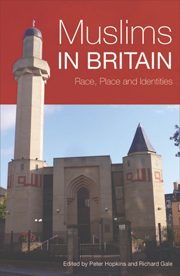Book contents
- Frontmatter
- Contents
- Acknowledgements
- List of contributors
- List of tables
- List of figures
- 1 Introduction: Muslims in Britain – race, place and the spatiality of identities
- Section 1 Gender, place and culture
- Section 2 Landscapes, communities and networks
- Section 3 Religion, race and difference
- Afterword
- Index
Afterword
Published online by Cambridge University Press: 05 August 2013
- Frontmatter
- Contents
- Acknowledgements
- List of contributors
- List of tables
- List of figures
- 1 Introduction: Muslims in Britain – race, place and the spatiality of identities
- Section 1 Gender, place and culture
- Section 2 Landscapes, communities and networks
- Section 3 Religion, race and difference
- Afterword
- Index
Summary
Muslims in Britain shape their geographies; geographies shape their experiences. Documenting some of the ways in which place, locality and neighbourhood influence and are influenced by Muslims in Britain, the aim of this book is to contribute to understanding the ways in which these geographies intersect and interact with everyday life. The chapters make it clear that – from the home to the neighbourhood, the labour market to the community and from the nation to the experiences of transnational mobilities – the intersections and interactions of different geographies matter to the complex ways in which Muslims in Britain negotiate their everyday lives, structure their social relationships and navigate their experiences of inequality.
The contributors to this collection include human geographers, sociologists, educational researchers, religious studies scholars and others who sit between these and other disciplines. A key contribution of this collection is the way in which it highlights the importance of geographical issues – such as locality, neighbourhoods, communities and mobilities – in the lives of Muslims in Britain. Reflecting upon the different disciplinary backgrounds of the contributors leads us to question the various benefits of different geographical approaches and possible advantages of adopting an interdisciplinary perspective to our work in this field. In particular, there is scope for more intensive, reciprocal dialogue between geography and religious studies in exploration of the spatiality of Muslim identities, along the lines charted in the pioneering work of Kim Knott (2005).
- Type
- Chapter
- Information
- Muslims in BritainRace, Place and Identities, pp. 228 - 230Publisher: Edinburgh University PressPrint publication year: 2009



